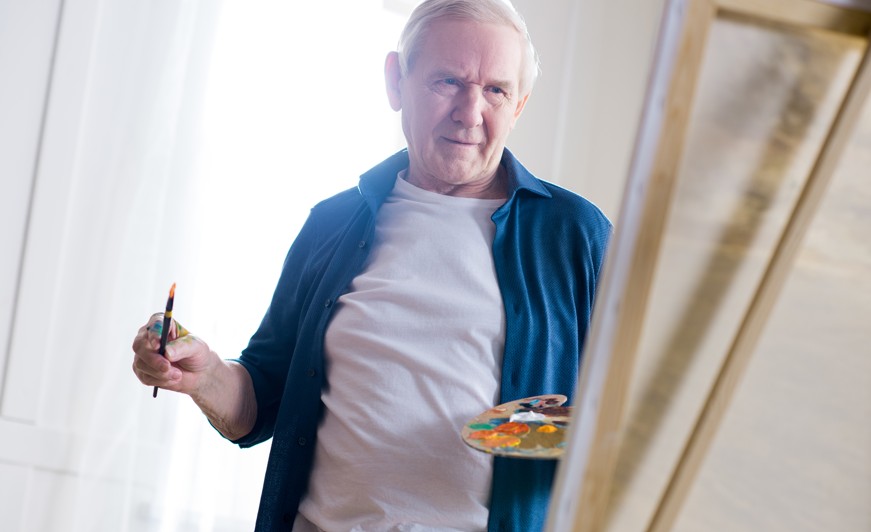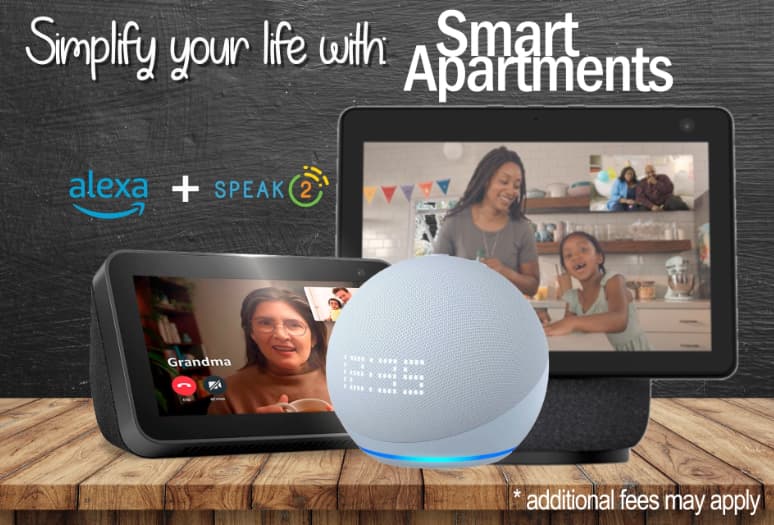Imagine a place where your loved one isn’t defined by their diagnosis but celebrated for their individuality. In our community, Memory Care is more than just specialized support—it’s an invitation to connect through the universal experiences that bring us all together: music, art, laughter, and friendship.

For families considering Memory Care, the journey often comes with questions and concerns: Will my loved one feel isolated? Will they find joy in this new chapter? The answer lies in the heart of our approach. Memory Care isn’t separate from the rest of our community—it’s woven into the vibrant fabric of shared experiences, where residents participate in activities that foster genuine connection.
From the simple joy of a shared dance to the creativity sparked in an art class, our Memory Care residents engage in activities that transcend words and diagnoses. These universal languages of joy—singing, painting, and even laughter—remind us that true connection doesn’t require memory, only presence.
How Shared Experiences Build Bridges in Memory Care
Caring for a loved one with memory challenges often comes with questions about their ability to connect with others. Will they find joy in meaningful interactions? Can they still build relationships? Research and real-world practices show that shared experiences—rooted in universal activities like music, art, and laughter—are powerful tools to foster connections and improve quality of life in Memory Care settings.
The Science of Shared Experiences
Shared experiences tap into the parts of the brain that remain resilient, even in the face of cognitive decline. Studies by organizations such as the Alzheimer’s Association highlight how activities like singing or painting stimulate emotional memory and social engagement, which are often preserved longer than factual memory.
“Music activates regions of the brain associated with memory, emotions, and mood regulation, helping individuals reconnect with their sense of self and others,” explains Dr. Jane Miller, a geriatric psychologist.
This means that even when words fail, activities like group singing or art classes become a bridge between individuals, sparking joy and connection.
Key Components of Shared Experiences in Memory Care
- Art as a Universal Language
Visual arts provide an outlet for self-expression that doesn’t rely on verbal communication. Residents often bond over collaborative projects like murals or craft-making.- Fact: A study published in Frontiers in Psychology found that engaging in creative activities improves mood and reduces agitation in individuals with dementia.
- The Power of Music
Group sing-alongs or listening sessions create a shared sense of purpose. Familiar melodies often trigger emotional memories, allowing residents to connect with each other.- Fact: Music therapy has been shown to decrease symptoms of depression and anxiety while improving social interaction among Memory Care residents.
- Laughter as a Connection Tool
Humor and play are universal human experiences. Activities like group games or storytelling sessions promote laughter, breaking down barriers and encouraging camaraderie.- Fact: Research from the Journal of Aging Studies suggests that laughter reduces stress and fosters emotional bonds in communal living environments.
- Group Activities That Build Friendship
Activities like gardening, baking, or even simple morning stretches in a group setting create opportunities for natural interactions and shared accomplishments.
Questions Families Often Ask About Shared Experiences in Memory Care
- How do these activities benefit my loved one’s health?
Activities like art and music promote emotional well-being, reduce anxiety, and help maintain cognitive abilities longer. These experiences also foster a sense of belonging. - Will my loved one feel left out if they have trouble participating?
Not at all. Activities are designed to be inclusive, allowing each resident to engage at their own pace while feeling part of the group. - Can family members participate in these shared experiences?
Yes! We encourage families to join events, strengthening the bond between residents and their loved ones. - How do shared experiences improve social connections?
Through non-verbal communication, residents bond over activities like dancing or gardening, which require collaboration and create lasting friendships.
The Role of Art and Music in Creating Lasting Connections
Art and music have always been powerful forms of communication, transcending barriers of language, age, and even memory. In Memory Care, these universal mediums become tools for connection, helping residents express themselves, engage with others, and find joy in shared experiences. For families considering Memory Care, understanding how art and music enhance emotional and social well-being can bring reassurance and hope.
How Art Creates Emotional Bridges
Art allows individuals to express what words cannot. In Memory Care, residents often participate in activities like painting, sculpting, or crafting, which engage their creativity while providing a sense of accomplishment.
- Expression Without Words: Cognitive decline may limit verbal communication, but visual art taps into emotional and sensory memories, enabling residents to share their thoughts and feelings through colors, shapes, and textures.
- Collaborative Projects: Group art sessions encourage residents to work together on murals or themed crafts, fostering a sense of community and belonging.
“Art therapy gives residents a voice, even when they can’t find the words,” says Dr. Carla Roberts, an art therapist specializing in dementia care.
The Transformative Power of Music
Music has a unique ability to evoke memories and emotions, often reaching areas of the brain unaffected by cognitive decline. In Memory Care, it plays a pivotal role in creating lasting connections.
- Triggering Emotional Memories: Familiar songs from residents’ youth often spark recognition and joy, allowing them to reconnect with their past and share those moments with others.
- Promoting Social Interaction: Group sing-alongs, musical games, and dance sessions bring residents together, creating a shared sense of joy and purpose.
- Reducing Anxiety and Agitation: Studies from the Journal of Music Therapy show that personalized playlists or calming melodies can soothe residents, improving their emotional well-being.
“Music is like a bridge—it connects people to their memories, emotions, and each other,” explains Dr. John Peters, a neurologist studying the effects of music on the brain.
Why Art and Music Work in Memory Care
Both art and music are rooted in universal human experiences. They bypass the limitations of language or memory, allowing residents to connect on an emotional and sensory level.
- Non-Threatening Engagement: Residents participate at their own pace, free from judgment, which builds confidence and reduces stress.
- Stimulating the Senses: Art and music engage multiple senses, activating brain regions associated with memory, emotions, and social behavior.
- Fostering Inclusion: These activities encourage interaction not only among residents but also with caregivers and families, strengthening bonds.

The Seamless Integration of Memory Care into Our Community
For families exploring Memory Care, one common concern is whether their loved one will feel isolated or disconnected from the larger community. At Legacy Ridge at Buckhead, our approach to Memory Care ensures that residents not only receive specialized support but also thrive in an environment where they are fully integrated into daily life and experiences with others.
By focusing on inclusion, universal activities, and personalized care, Memory Care becomes part of the vibrant heartbeat of our community, fostering connections, joy, and dignity for every individual.
What Does Seamless Integration Look Like?
Integration in Memory Care involves creating opportunities where residents can participate in shared experiences while receiving the tailored support they need. Here’s how we achieve this balance:
- Universal Activities: Residents join others in activities like group fitness, live entertainment, and gardening, fostering connections through shared interests.
- Specialized Programming: Memory Care residents benefit from brain fitness programs and SPIRIT, our signature individualized care program, ensuring their unique needs are met while enjoying a community atmosphere.
- Inclusive Spaces: With amenities like a movie theater, game room, and raised garden beds, residents seamlessly engage in the same vibrant environment as everyone else.
Why Integration Matters for Families and Residents
- Strengthening Connections Through Shared Experiences
Activities like art classes, group dining, and live entertainment bring residents and their neighbors together. These moments allow Memory Care residents to feel part of the broader community, enhancing their emotional well-being and reducing feelings of isolation.
“Belonging is key to emotional health, especially for individuals with memory challenges. By integrating Memory Care residents into the community, we ensure they experience a sense of purpose and connection,” explains Dr. Maria Taylor, a gerontologist specializing in dementia care.
- Building Confidence Through Support
While Memory Care residents participate in shared activities, our specially trained associates are always nearby to provide assistance, creating an environment where residents feel safe to explore, interact, and enjoy their day.
Key Features That Foster Integration
Personalized Care in Shared Spaces
- Residents receive individualized attention for daily tasks like bathing, dressing, and grooming, allowing them to comfortably participate in community life.
Chef-Inspired Dining for All
- Shared meals in a communal dining setting encourage conversation and camaraderie while ensuring Memory Care residents receive any dietary accommodations they need.
Onsite Primary Care Services
- With Curana Health’s concierge-style primary care, residents can receive medical attention without leaving the community, promoting a sense of security and convenience for families.
- Advanced technology ensures timely reminders and clear communication between caregivers and residents, offering peace of mind to families and enhancing the consistency of care.
With Alexa and Speak 2 in our apartments, we aim to provide increased convenience, security, and overall satisfaction within our senior community.
Frequently Asked Questions About Memory Care Integration
- Will my loved one have opportunities to interact with others outside of Memory Care?
Yes! Our activities and amenities are designed to be inclusive, allowing Memory Care residents to engage with other members of the community in meaningful ways. - How do you balance safety with integration?
We provide 24/7 trained associates and emergency response systems, ensuring that residents can safely participate in all activities while receiving necessary support. - Can families visit and participate in activities?
Absolutely. We encourage family involvement, whether it’s joining a gardening session, sharing a meal, or attending one of our live entertainment events. - What if my loved one needs a quiet space?
Our community offers quiet areas and personalized care plans, ensuring each resident has the balance of stimulation and calm they need.
A Day in the Life of Memory Care Residents
Here’s how Memory Care residents integrate seamlessly into our community:
- Morning: Gentle group exercise or a stroll in the garden beds.
- Midday: A shared chef-inspired meal with neighbors in the dining hall.
- Afternoon: Creative activities like painting or a movie screening in the theater.
- Evening: Live music performances or a calming storytelling session.
Every moment is designed to balance care, connection, and joy, ensuring that residents feel valued and included.
Conclusion
Seamless integration of Memory Care into our community means your loved one will never feel apart from life’s vibrant experiences. Through inclusive activities, personalized care, and a welcoming environment, we ensure that every resident thrives, finds joy, and builds meaningful connections. This is more than Memory Care—it’s living life to its fullest potential, together.






